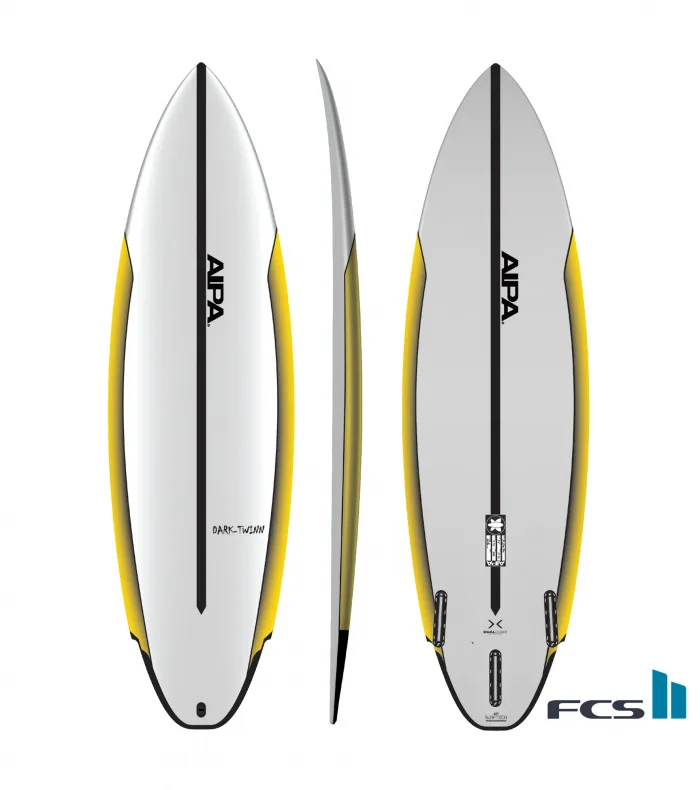Description
Aipa Dark Twinn – Dual Core – FCS II – 3 Fin
The Dark Twinn was developed as part of Aipa’s Dark Series, a series of new designs inspired by Ben Aipa’s classic shapes and modernized for futuristic surfing. The Dark Twinn combines Ben’s Wing Twin template, used to make Dane Kealoha’s twins in the late ‘70s and ‘90s, with an updated Swing Twin Squash template for a modern feel.
The shift in wing placements engages the wing-to-fin relationship and accents how the board performs as a twin fin. Featuring, Mid-range rockers, and a lowered rail apex line, the Dark Twinn is a high-performance groveler built for aggressive surfing in soft waves.
A staged bottom contour with a blended roll from the nose down into a single concave under the forward foot transitions into a double concave that is deepest between the forward fins. The concave then blends with a healthy amount of vee/double-concave, starting at the wing, and easing through the tail.
The Dark Twinn is a lively and responsive board proven from Pismo Beach mush to juicy Hawaiian surf.
| Dimensions | Volume |
| 5’6 x 19 3/8” x 2 5/8” | 28.86 ltr |
| 5’7 x 19 1/2″ x 2 11/16” | 29.48 ltr |
| 5’8 x 19 3/4″ x 2 11/16” | 31.03 ltr |
| 5’9 x 19 7/8” x 2 3/4″ | 32.43 ltr |
| 5’10 x 20” x 2 3/4″ | 33.13 ltr |
| 5’11 x 20 1/4″ x 2 13/16” | 34.79 ltr |
| 6’0 x 20 1/2″ x 2 13/16” | 35.87 ltr |
| 6’2 x 21” x 2 7/8” | 38.69 ltr |
Dual Core
One board that combines the best of both EPS and PU surfboards. While the EPS is lively the PU inserts dampen vibration better. The result is pop out of turns and stability while on rail. With Dual Core construction you will never have to sacrifice again.
- FUSED CELL EPS CORE (DUAL-CORE W/PU RAILS) // Closed cell EPS core provides more response + Flotation
- CLEAR HD-EPOXY RESIN // Epoxy resin with high thermo-mechanical performances
- HIGH-QUALITY E-GLASS FIBERGLASS // E-glass has the highest strength to weight ratio available
- FULL BIAX DECK PATCH (45° / -45°) // The Biax fiberglass distributes power + protects from dings
- POP-FLEX STRINGER (TPU) // TPU adds pop + feel / EVA adds dampening + feel
- PU FOAM RAIL INSERTS (DUAL-CORE W/EPS CENTER) // PU rails adds drive in and out of turns + swing weight for airs
- CARBON STRINGER // Distributes power. Protects from dings. Adds break strength
- CARBON TAIL PATCHES // Distributes power to the fins + protects from toe/heel dings
- PATENTED TECHNOLOGY // An exclusive technology by Surftech
A Legacy of Aloha
Ben Aipa has made a most significant mark in the world of surfing: making the board that fellow Hawaiian Fred Hemmings used to win the World Championship in 1968 and founded his own brand Aipa Surfboards in 1970. Ben invented the doubled-edged swallowtail design in 1972 and followed this with the split-tail design in 1974. Moreover, Ben has served as an informal coach and trainer to such top surfers as Michael Ho, Larry Bertleman, Mark Liddell, Sunny Garcia, Brad Gerlach, and Kalani Robb.
Ben Aipa continued to enter and compete in various surfing contests: He won the grandmasters division of the 1989 United States Surfing Championship and the legends division of the 2000 U.S. Championships. Inducted into the Surfing Hall of Fame in 1992, Ben was named one of the Top Ten Shapers of All-Time by Surfing magazine in 2004. Now spearheaded by sons Duke and Akila, Ben’s legacy continues with fresh shapes and ideas from the minds of his talented children.
“I was never watching what other board builders were doing…I was watching the surfers and the natural world around me. Their movements showed me what was missing…I was always looking for the next wave, the next move.” – Ben Aipa



